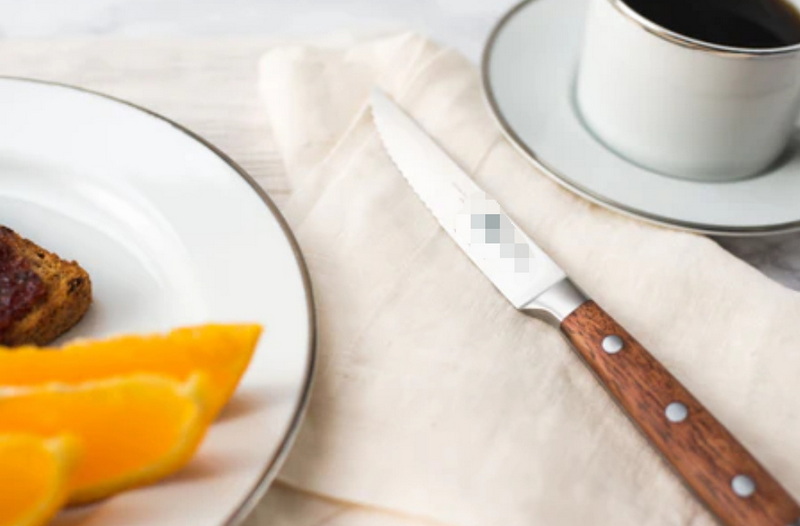- All
- Product Name
- Product Keyword
- Product Model
- Product Summary
- Product Description
- Multi Field Search
Views: 222 Author: Ann Publish Time: 2025-11-03 Origin: Site











Content Menu
>> Serrated vs straight-edge steak knives
>> Bevel angles and edge geometry
>> Material and construction drivers
>> Maintenance and performance longevity
>> OEM considerations for foreign brands
● Materials and finishes deep dive (for OEM messaging)
● Maintenance best practices for end-users (to include in product literature)
● Future-proofing your OEM Steak Knife line
● FAQs
>> 1) What edge type is best for cutting steak smoothly?
>> 2) How does blade angle affect slicing performance?
>> 3) Which blade material is ideal for professional kitchens?
>> 4) How often should a Steak Knife blade be sharpened?
>> 5) Are Damascus or laminated blades worth it for OEM lines?
In professional kitchens and premium home dining alike, the edge type of a Steak Knife directly influences cutting performance, tissue integrity, and plate presentation. A well-chosen edge minimizes tear, preserves juice, and delivers consistent slice thickness—critical factors for brand consistency in OEM programs serving foreign brands, wholesalers, and manufacturers. This article examines the main edge options, blade materials, maintenance strategies, and OEM considerations to help kitchen-tool brands optimize their Steak Knife lines for diverse markets.

- Serrated blades feature jagged teeth designed to saw through tougher exteriors while maintaining interior moisture. They excel in high-volume environments where quick turnaround and minimal sharpening are valued. Serration can reduce the need for frequent honing but may compromise ultra-clean slices on delicate or lean cuts over time. For OEM lines targeting broad retail and hospitality segments, serrated edges offer durability and broad appeal.
- Straight-edge blades rely on a continuous, finely honed edge that yields clean, precise slices with minimal tearing. They demand regular maintenance (honing and periodic sharpening) but reward users with superior presentation and consistent portioning, especially for tender cuts. For premium steak experiences and brand storytelling around “Steak Knife” performance, straight edges often stand out in product sheets and showroom demonstrations.
- Bevel angles around 15 degrees per side are common for high-quality straight-edge blades, balancing sharpness with toughness. Some premium models incorporate micro-bevels to refresh a razor edge without heavy grinding. For OEM programs, specifying a consistent bevel angle across batches helps maintain uniform cutting performance and customer satisfaction.
- Serrated edges operate differently; their tooth geometry maintains some cutting effectiveness as the blade dulls, but performance can still decline without periodic maintenance. Clear guidance on serration pitch, tooth shape, and expected service intervals is important for downstream education and warranty planning.
- Material choice influences edge retention, corrosion resistance, and ease of maintenance. High-carbon stainless steels (HRC typically in the mid-50s to low-60s) provide a practical compromise for restaurant settings and consumer markets, aligning with the durability expectations of OEM buyers. In marine or offshore environments, corrosion resistance becomes even more critical, guiding alloy selection and protective finishes.
- Forged versus stamped blades impact overall edge stability and balance. Forged blades often deliver superior balance and toughness, which can translate into smoother cuts and better long-term performance in a “Steak Knife” line designed for rigorous use in restaurants and luxury home kitchens.
- Finishes, such as mirror polish or satin, influence aesthetics, ease of maintenance, and resistance to micro-scratches. For marketing collateral, consistent finishes across an OEM line reinforce perceived quality and durability.
- Honing maintains the edge between sharpenings and can preserve a straight-edge blade's performance for longer periods when used properly. Guidance on compatible honing rods and frequency helps customers sustain performance and reduces edge-deterioration complaints.
- Sharpening regimes vary by edge type. Straight-edge blades require periodic sharpening with guided angle systems or whetstones to restore micro-bevels, whereas serrated blades often benefit from professional sharpening services that address individual teeth or specialized serration files.
- Cleaning and storage practices also affect edge longevity. Stainless steel blades offer robust corrosion resistance and dishwasher compatibility in many markets, while high-end lines may recommend handwashing to preserve finish and ensure longevity. For OEM packaging, including care instructions that cater to regional washing practices and water hardness improves user satisfaction.
- Specification alignment is essential. Define edge type, blade material, hardness targets, and finish consistently across production runs to ensure uniform performance for partner brands and their customers.
- Documentation and education. Provide maintenance guides, usage tips, and warranty language that helps downstream customers understand how to maximize the Steak Knife's life and performance.
- Stainless steel vs carbon steel
- Stainless steel is favored for its corrosion resistance and ease of cleaning, aligning with commercial kitchens and hotel settings. Carbon steels can deliver exceptionally sharp edges but require more diligent maintenance, which should be addressed in care instructions.
- Laminated or Damascus-style blades
- Lamination or Damascus patterns add premium aesthetics while potentially enhancing edge stability and resistance to chipping when properly heat-treated. For marketing, highlight both beauty and performance, but ensure QA documentation covers maintenance expectations to avoid misalignment with customer expectations.

- Honing versus sharpening
- Emphasize honing as a routine maintenance step to refresh the edge, with sharpening scheduled based on usage intensity. Provide recommended hone and sharpening tools compatible with the blade type.
- Cleaning guidance
- Recommend handwashing for premium lines and discuss dishwasher compatibility where appropriate, including notes on drying and storage to prevent corrosion or staining.
- Storage solutions
- Suggest knife blocks with built-in edge protection or magnetic bars that minimize nicks and keep edges aligned, contributing to longer service life.
- Standardized QA checks
- Implement non-destructive edge inspection, hardness testing, and bend/flex tests to ensure consistent performance across production batches.
- Packaging and documentation
- Develop bilingual (English-Chinese) care guides, warranty cards, and quick-start tutorials to support global distributors and maintain brand consistency.
Choosing the right edge for a Steak Knife involves balancing cutting performance, maintenance needs, and OEM-focused considerations. Straight-edge blades usually deliver the cleanest cuts and best juice retention for premium steak experiences, while serrated edges offer durability for high-volume environments. For OEM programs, couple the chosen edge type with clear care instructions, robust materials, and media-rich marketing collateral to clearly communicate value. A well-documented specification package, bilingual care literature, and high-quality visuals can elevate an OEM partner's market position and help end-users enjoy consistently excellent steak experiences.

- Straight-edge blades typically provide the smoothest cuts with the least tearing, especially on tender cuts, while serrated edges excel in durability on tougher exteriors. This choice hinges on target cuts and maintenance capabilities for OEM partners.
- A finer bevel angle increases initial sharpness and reduces cutting resistance, improving juice retention and presentation, though it may require more frequent maintenance.
- High-carbon stainless steels offering a balance of hardness and corrosion resistance are common choices; select an alloy with a tested hardness suitable for the intended cleaning regime and use-case.
- Regular honing should be performed frequently, with sharpening scheduled based on use frequency and blade type; professional services may be needed for serrated edges to maintain tooth integrity.
- They offer premium aesthetics and potential edge stability but require clear maintenance guidance so customers know how to care for the blade's finish and pattern.
The Ultimate Professional Knives for Halal Butchery in Middle Eastern Kitchens
Chef Knife Size Guide: Choosing Between 6″, 8″, 10″, And 12″
Custom Knife Handles: How To Design A Chef Knife That Fits Your Hand Perfectly
Chef Knife Surface Treatments Guide: From Polished Migaki To Damascus Patterns
Inside Our Professional Knife Sample Room: Quality You Can See
Universal Knife Block Buying Guide: Modern Acrylic & ABS Knife Holders for Professional Kitchens
Universal Knife Block: The Complete Guide To Modern, Hygienic Knife Storage
The Complete Guide To Red Handle Knife Sets: Style Meets Functionality in The Kitchen
Professional Knives for Halal Butchery And Middle Eastern Cuisine